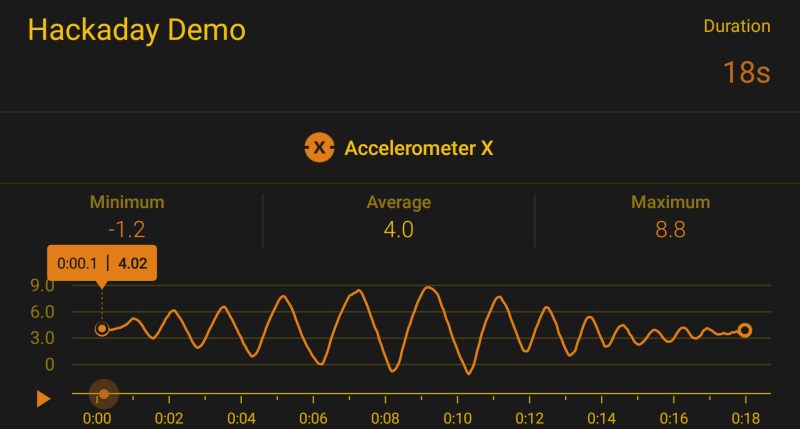When project inspiration strikes, we’d love to do some quick tests immediately to investigate feasibility. Sadly we’re usually far from our workbench and its collection of sensor modules. This is especially frustrating when the desired sensor is in the smartphone we’re holding, standing near whatever triggered the inspiration. We could download a compass app, or a bubble level app, or something similar to glimpse sensor activity. But if we’re going to download an app, consider Google’s Science Journal app.
It was designed to be an educational resource, turning a smartphone’s sensor array into a pocket laboratory instrument and notebook for students. Fortunately it will work just as well for makers experimenting with project ideas. The exact list of sensors will depend on the specific iOS/Android device, but we can select a sensor and see its output graphed in real-time. This graph can also be recorded into the journal for later analysis.
Science Journal was recently given a promotional push by the band OK Go, as part of their OK Go Sandbox project encouraging students to explore, experiment, and learn. This is right up the alley for OK Go, who has a track record of making music videos that score high on maker appeal. Fans would enjoy their videos explaining behind-the-scene details in the context of math, science, and music.
An interesting side note. Anyone who’s been to Hackaday Superconference or one of the monthly Hackaday LA meetups will likely recognized the venue used in many of the OK Go Sandbox videos. Many of them were filmed at the Supplyframe Design Lab in Pasadena. It’s also nice to see AnnMarie Thomas (Hackaday Prize Judge from 2016 and 2017) collaborated with OK Go for the Sandbox project.
While the Science Journal app has provisions for add-on external sensors, carrying them around would reduce its handy always-available appeal. Not that we’re against pairing smartphones with clever accessories to boost their sensing capabilities: we love them! From trying to turn a smartphone into a Tricorder, to an inexpensive microscope, to exploring serious medical diagnosis, our pocket computers can do it all.
[via Engadget]















There used to be a little app called Tricorder, styled after the Star Trek instrument that also offered access to a lot of sensors (grav, magnetometric, acoustic (decibels and spectral plot), EMF (wifi/GSM), GPS, and a solar activity feed). Sadly, it was pulled from the Play Store due to copyrights, but I keep the APK around since I have fond memories of the program.
Same here have the apk, great app
If it was just because of Star Trek copyrights (name, look and feel) it could be renamed and re-imaged to remain a useful app.
I used to have this on my Palm PDA – lots of fun.
A year ago I wrote a simple app, that can help you transfer sensor data over TCP or UDP to a computer and than process it e.g. with a Python script: It is called SensorStreamer: https://play.google.com/store/apps/details?id=cz.honzamrazek.sensorstreamer
If you would consider adding MQTT to the list of streaming options, this app would be in daily use by myself and a group of others (who are trying to use old Android photos as IoT sensors).
The project is open-source. Feel free to implement the support. However, implementing MQTT is not my priority now.
https://github.com/yaqwsx/SensorStreamer
Can it detect gravitational waves?
Also, I’m still waiting for the promised smartphones with cheap spectroscopes.
And what I really want is a smartphone with an integrated SDR, that can transmit and receive from 1kHz to 6GHz, and is freely programmable.
I think you are asking for a lot…
those functionalities could be put on a “backpack” for a phone that communicates through OTG, but allows for better
inputs (such a better antenna(s) optical sensors for spectronomy, better microphone (not optimized for human speech), better connections for probes (oxymetry, voltage, current, temperature, EKG).
Such a “backpack” (hat/shield/cape/butt plug etc.) would allow existing phones to use it and could/should include additional battery power. It could/should also be OSS, thereby not subject to a phone company or manufacturers whims.
Maybe some phone manufacturers could incorporate a type of “GeekPort” (TM) to allow better communication between the phones processor(s), memory, and transmitter. Again, I hope such a connector would be Open Source.
Motorola’s “Moto Mods” is similar to your “GeekPort” but is proprietary to their Moto Z line of phones.
You should try Phyphox to have some fun with your phone’s sensor: http://phyphox.org/
I’d love to see some sort of connection between the sensors in the phone (other than the microphone) and the (audio only) waveform processing apps that are widely available. Getting a waterfall/FFT out of vibration data can be very handy for machine analysis and I’m sure there are a host of other applications for similar sorts of things.
Phyphox has it built in – (oh, joy!!).
A trend I would like to see. Phones with more sensors, like say chemical. Geeks wouldn’t be the only beneficiaries. Citizen scientists, and even field medicine.
a phone with more sensors would be nice, but a phone with less sensors would also be nice